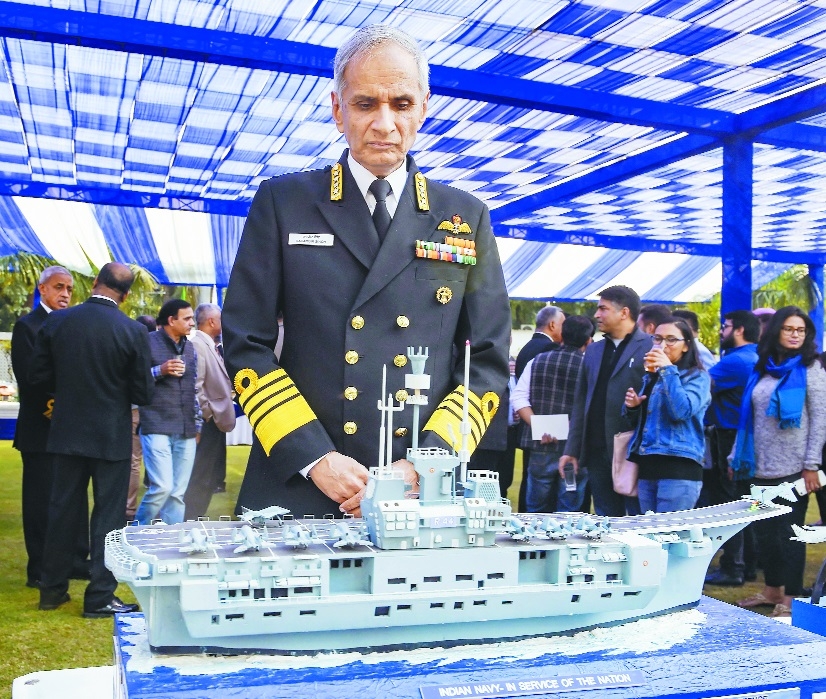Navy’s long-term plan is to have three aircraft carriers: Navy chief
| Date :04-Dec-2019 |

Chief of Naval Staff, Admiral Karambir Singh watching a model of a naval ship after a press conference in New Delhi on Tuesday. (PTI)
NEW DELHI :
Admiral Singh flags concern over decline in funds allocation to Navy
The Navy’s long-term capability plan is to have three aircraft carriers so that two carrier battle groups are ready for deployment in the Indian Ocean Region round-the-clock. In a press conference on the eve of the Navy Day, the Navy Chief said the first indigenous aircraft carrier (IAC) will be fully operational by 2022 and it will have a fleet of MiG-29K aircraft.
Against the backdrop of China’s aggressive naval expansion, Navy Chief Admiral Karambir Singh on Tuesday pitched for higher budgetary allocation for his force, flagging concerns over decline in the Navy’s share in defence allocation from 18 per cent in 2012-13 to 13 per cent in 2018-19. In a reference to Indian Navy driving out a Chinese PLA ship from India’s Exclusive Economic Zone in September, the Navy Chief asserted that such activities will be dealt with sternly. According to plans, he said the second IAC will be 65,000 ton CATOBAR aircraft carrier with electric propulsion and that Navy will shortly approach the Government seeking approval for the project. At present, the Navy is operating Russian-origin INS Vikramaditya which is India’s only aircraft carrier.
On China’s increasing forays into the Indian Ocean Region, Admiral Singh said seven to eight Chinese ships are usually present in region at any point of time. Asked why China has not been invited to the Milan maritime exercises along with 41 other countries, he said only like-minded nations will be part of it. Admiral Singh also assured the nation that the Navy is fully prepared to deal with national security challenges. On the proposed Chief of Defence Staff (CDS), he said the position should be adequately empowered to implement strategic plans. Referring to the Navy’s modernisation plan, Admiral Singh said it was a fact that the budget for the force has declined from 18 per cent in 2012-13 to 13 per cent in 2018-19. “Our hope is that we get some more funds.”
It is learnt that the Navy has already communicated to the Prime Minister’s Office the need for adequate funds for modernisation of the force. On the challenges in the neighbourhood, he said that no action of any other player in the region should impact India, and if it does then, the force will deal with it appropriately. Asked about the situation in the Indo-Pacific region, the Navy Chief said Indian Navy was ready to work with like-minded nations based on common interests of ensuring safe and secure seas and promote rules-based order. He also said that the quadrilateral coalition of India, the US, Japan and Australia does not have a military role in the Indo-Pacific region at the moment.
The Navy Chief also said that India is playing a stabilising role in the Indo-Pacific region. To a query on the massive expansion of the Chinese Navy, he said they are moving at the pace they are capable of and “we are moving at the place we are capable of”. On whether the Navy has any plan to conduct an exercise with China, Admiral Singh suggested that he was not the person to take such a decision. “It is beyond my pay grade,” he quipped. Navy Chief Admiral Karambir Singh said that the force is fully committed to “Make in India” vision and underlined that since December 2018, close to 88 per cent of Indian Navy’s contracts and acceptance of necessity (AoN) by value have been concluded with or accorded to Indian vendors.
Navy drives away suspicious Chinese vessel from Indian waters
New Delhi :
Dec 3
The Indian Navy forced China’s People’s Liberation Army (PLA) ship to return after it entered India’s exclusive economic zone in the Andaman Sea in September, officials said on Tuesday. Asked about the incident during a press conference, Navy chief Admiral Karambir Singh said anyone operating in “our region, will have to notify Indian Navy”. The officials said the Chinese Navy’s research ship was forced to leave the area as it had not sought permission to come there. Snooping by Chinese naval ships increased in Indian Ocean: Navy officer: SNOOPING by Chinese naval ships in the Indian Ocean has increased over the last few years, but the Indian Navy has been able to keep effective surveillance over such activities, Naval Officer-in-charge, Bengal Area, Commodore Suprobho De said here on Tuesday. He said the Indian Ocean has some choke points which help the Navy in keeping an eye on the activities in the region, including the Bay of Bengal.
“With the P-8I long range maritime patrol aircraft in service, we can keep an eye on activities over the Indian Ocean,” De told newspersons here on the eve of the Navy Day. India at present operates eight P-8I long-range sea patrol aircraft and the Navy has placed an order for an additional four planes from the manufacturer, Boeing. The boost to the Indian fleet will come at a time when the Chinese Peoples Liberation Army Navy (PLAN) is seen increasing its footprints in the Indian Ocean. By 2021, India will have a 198-ship navy, which now has 131 ships of various makes, De said.
He said a number of warships, including destroyers, corvettes and an aircraft carrier are under various stages of construction at Defence PSU shipbuilders, including the Garden Reach Shipbuilders and Engineers Ltd (GRSE) here. The naval officer-in-charge said though West Bengal has only around 160 km-long coastline, there are 73 landing points. The difficult riverine Sunderbans in the region is used by smugglers, anti-nationals and traffickers, he said. De said the Navy keeps surveillance in the area to keep a tab on such activities and coordinate with the BSF, Coast Guard and the state police.